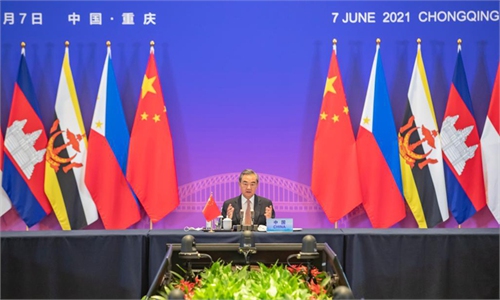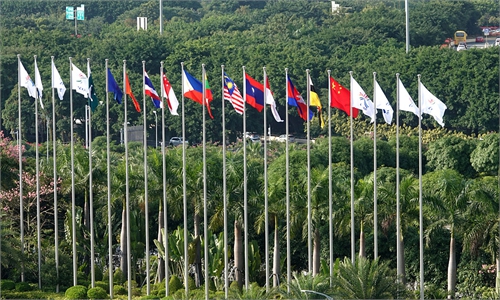COMMENTS / EXPERT ASSESSMENT
High complementarity to boost China’s investment in ASEAN

Illustration: Xia Qing/GT
The enhancing economic ties between China and the Association of Southeast Asian Nations (ASEAN) have drawn attention worldwide, especially against the backdrop of intensifying China-US tensions. Recently Japan-based Nikkei listed several new investment projects from China to ASEAN countries, saying that China outspends the US in order to "undermine the US in the race for greater influence in the region".In the report, it listed a $10.1 billion-worth of solar panel plant in Malaysia, and a $5.1 billion-worth of highway in Laos. Indeed, China has been one of the major investors for infrastructure projects in Southeast Asian countries; but surging investment from China in the region is based on higher complementarities between the two sides, rather than the so-called "influence race" with the US or any other country.
In 2020 when the COVID-19 pandemic drastically cut global foreign direct investment (FDI) flows by 35 percent and Southeast Asian economies saw a FDI plunge of 25 percent, some statistics showed China's investment in ASEAN surged 52.1 percent year-on-year to $14.36 billion.
With the mega free trade deal Regional Comprehensive Economic Partnership (RCEP) inked last November, it is expected that various trade and economic cooperation between China and ASEAN members will be further accelerated.
In fact, the US has been a major investor in Southeast Asian nations as well, with an annual investment growth rate of 10 percent in the region during the past decade, according to media reports.
Majorly focusing on mineral resources and high-tech sectors, however, the US' investment in the region has been lacking presence in infrastructure areas which is exactly one of the most prominent shortages for the development of the region.
By contrast, China and ASEAN members enjoy great complementarities in infrastructure cooperation which China has developed leading advantages in construction experience, talent, as well as capital.
Though the US, together with other G7 rich countries have recently rolled out a so-called Build Back Better World initiative focusing on infrastructure investment in developing countries, the plan, which widely regarded as a rival China-proposed Belt and Road Initiative, can hardly be a fruitful one since the tremendous challenge they faced to stimulate the participation of private capital.
It is plain for all to see the hardship for private capitals joining infrastructure which demand huge investment and longer payback periods.
Meanwhile, the promising infrastructure cooperation is not the only driver for the enhancing economic ties of China and ASEAN; as close neighbors, the two enjoy profound cooperative history and complementary advantages of economic and industrial structures.
Not only that ASEAN has surpassed the EU to become the largest trading partner of China last year, now with RCEP coming into effective in the near future, nearly 90 percent of surveyed Chinese companies showed intention to accelerate investment in ASEAN countries, according to a report conducted by Standard Chartered Bank.
Whether there is US' intention to increase investment in the area or not, China's investment growth in ASEAN was driven by promising economic cooperation of the two sides. It is more than welcome to see developed nations increasing investment to help developing economies during the post-COVID recovery era, but launching zero-sum games toward China in the area are not in line with the development of the region, and ASEAN members are clear about that.
The article was compiled based on an interview with Xu Liping, director of the Center for Southeast Asian Studies at the Chinese Academy of Social Sciences. bizopinion@globaltimes.com.cn



